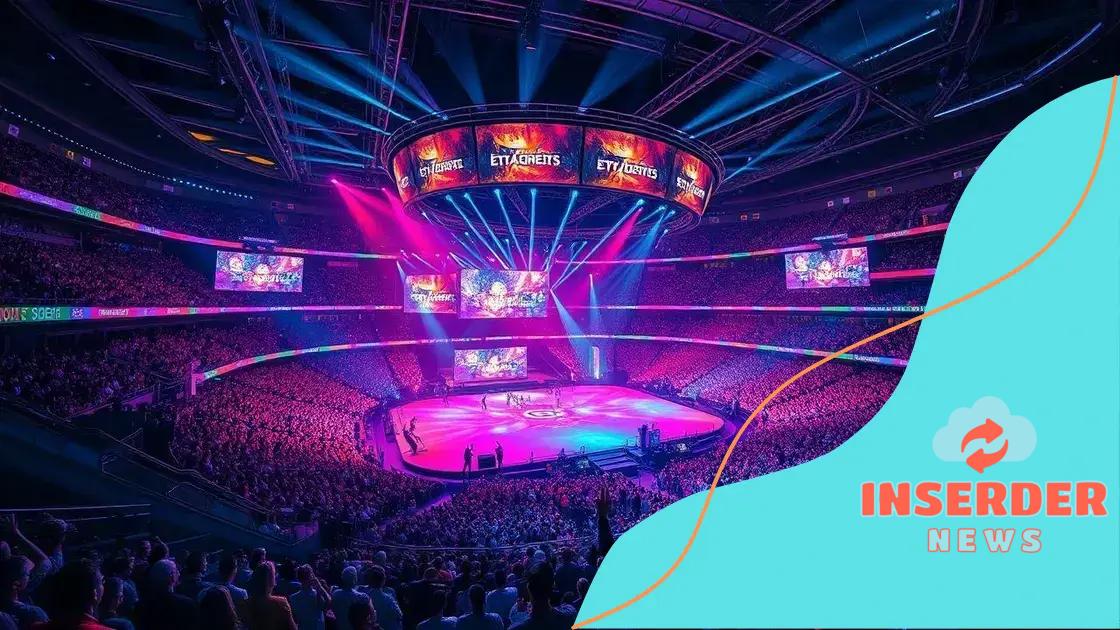How e-sports are becoming a billion-dollar industry

How e-sports are becoming a billion-dollar industry is driven by increased investments, technological advancements, and growing mainstream acceptance, resulting in significant sponsorship opportunities and a diverse, engaged audience.
How e-sports are becoming a billion-dollar industry might surprise you. With millions of viewers worldwide, competitive gaming is more than just a pastime—it’s a lucrative enterprise. But what drives this explosive growth?
The rise of e-sports popularity
The rise of e-sports popularity is nothing short of remarkable. Over the past decade, competitive gaming has transformed from a niche hobby into a global phenomenon. Major tournaments fill arenas with thousands of enthusiastic fans, and millions more tune in online. This shift highlights a new era where gaming is not just for fun but a serious competitive sport.
Key Factors Driving Growth
Several elements contribute to the surge in e-sports interest:
- Innovative streaming platforms allow fans to watch their favorite players live.
- Game developers are investing heavily in competitive scenes.
- Sponsorship deals and partnerships with major brands increase visibility.
Moreover, the diversity of gaming genres attracts various audiences. Titles like League of Legends, Fortnite, and Dota 2 cater to different tastes, broadening the appeal of e-sports.
Demographics of E-sports Fans
Another interesting aspect is the demographics of the audience. Not only are young people driving the rise of e-sports, but adults are also joining in. Observing age ranges helps brands target their marketing efforts:
- 18-24 years: The largest segment, often comprising college students.
- 25-34 years: A growing group that balances careers with gaming.
- 35+ years: This demographic is steadily increasing, showing that passion for gaming doesn’t fade.
As more fans engage, major companies recognize e-sports for its potential to reach vast audiences, leading to further investments and innovations.
The global community surrounding e-sports also thrives. Events often have international participation, uniting players from different backgrounds and creating opportunities for cultural exchange. This aspect adds a unique layer to the e-sports experience, making it more than just about gaming. Engaging with fellow fans worldwide fosters a sense of belonging and shared purpose.
The Future of E-sports Popularity
Looking ahead, the future of e-sports appears bright. The rapid growth is expected to continue as technology advances. Enhanced virtual reality experiences and immersive game worlds will likely attract even more fans and participants.
Key players in the billion-dollar e-sports market
The key players in the billion-dollar e-sports market are essential to understanding how this industry thrives. This ecosystem includes game developers, professional teams, broadcasters, and sponsors. Each player plays a crucial role in shaping the landscape of e-sports while driving its incredible growth.
Game Developers
At the heart of this market are the game developers. Companies like Riot Games, Valve, and Blizzard Entertainment create popular titles that form the backbone of e-sports. Their continuous support through updates, expansions, and events helps sustain player interest and engagement. These developers not only design the games but also host tournaments, incentivizing players to compete.
Professional Teams and Players
Professional teams also contribute significantly to the e-sports arena. Teams such as Team Liquid, Fnatic, and Cloud9 gather the best talent, competing in major tournaments worldwide. These players become celebrities in their own right, attracting fans and sponsors alike. Their skill and dedication inspire many young gamers to pursue a career in this exciting field.
- Top teams bring intense competition and showcase amazing skills.
- Many players have lucrative contracts, highlighting the professional nature of e-sports.
- Fan loyalty drives merchandise sales and sponsorship deals.
The influence of social media amplifies their impact, as fans follow their journeys and support their favorite players through various platforms.
Broadcasters and Streaming Platforms
Another vital segment of the e-sports market is the broadcasters and streaming platforms. Services like Twitch, YouTube Gaming, and Facebook Gaming provide a stage for gamers and events to reach millions. These platforms enable fans to connect with their favorite players and watch live matches. Community engagement is a big part of e-sports, with chat features and interactive content creating a sense of belonging.
Sponsors and Advertisers
Sponsorships and advertisers play a critical role in funding the growth of e-sports. Brands like Coca-Cola, Intel, and Red Bull invest heavily to reach the young, engaged audiences attracted to competitive gaming. Through partnerships, these companies help organize events, add value through promotions, and heighten visibility in this booming industry.
As the market continues to grow, these key players will adapt and innovate to meet the demands of fans and participants alike, ensuring that e-sports remains dynamic and exciting.
Impact of streaming platforms on e-sports

The impact of streaming platforms on e-sports has been transformative. These platforms have revolutionized how fans engage with their favorite games and players. By providing a venue for live broadcasts, they enhance the overall gaming experience, making it more accessible and exciting than ever.
Increased Accessibility
Streaming platforms like Twitch and YouTube Gaming have made e-sports events available to a global audience. Players from different regions can easily watch tournaments live, adding to a sense of community. This accessibility enables fans to support their favorite teams and players no matter where they are located.
Connecting with Audiences
Moreover, these platforms allow for direct interaction between gamers and their fans. Fans can engage with players through live chats while watching broadcasts. This interaction not only builds a stronger connection but also creates a sense of belonging within the gaming community. As fans comment and share their thoughts, it generates a lively and engaging atmosphere.
- Fan interaction through chat boosts community engagement.
- Players can respond to fans, fostering loyalty.
- Streamers often share tips and tricks, enhancing gameplay knowledge.
As players showcase their skills and fans cheer them on, the energy in these streaming spaces makes e-sports more thrilling to watch.
Monetization Opportunities
The growth of streaming has also opened new monetization opportunities for players and teams. Content creators earn money through subscriptions, donations, and sponsorships. This revenue helps sustain their gaming careers and boosts the overall economy of e-sports. Similarly, brands recognize the marketing potential of collaborating with popular streamers, which increases investment in the industry.
As more viewers flock to these platforms, advertisers seek to reach this engaged audience. Brands can effectively target younger demographics by sponsoring streamers and live events. This relationship creates a mutually beneficial environment where both the brands and the gaming community thrive.
In conclusion, the role of streaming platforms in the e-sports ecosystem cannot be overstated. They enhance accessibility, promote fan engagement, and foster new revenue streams, strengthening the connection between players and audiences while driving the entire industry forward.
Sponsorships and advertising in e-sports
Sponsorships and advertising in e-sports are critical elements that fuel the industry’s growth. As e-sports gain popularity, companies seek to connect with the young, engaged audience that participates in competitive gaming. These partnerships benefit both the brands and the e-sports community.
Why Sponsorships Matter
Sponsorships provide financial support to teams, events, and tournaments. This funding helps organize large-scale competitions and can dramatically enhance the player experience. Major companies like Red Bull, Intel, and Coca-Cola often sponsor teams or events to gain visibility among fans. Their logos become a familiar sight, creating brand loyalty and recognition.
Types of Sponsorships
There are different types of sponsorships in the e-sports field:
- Team Sponsorships: Companies sponsor professional teams to gain exposure during broadcasts and tournaments.
- Event Sponsorships: Brands support specific events, receiving advertising opportunities in exchange for financial backing.
- Streaming Sponsorships: Brands partner with popular streamers to promote products to their large followings.
These collaborations allow brands to connect directly with a passionate audience, making sponsorships a win-win situation for both sides.
Impact of Advertising
Advertising in e-sports is not limited to sponsorships. It also includes targeted ads during streams. Brands can run campaigns that reach viewers in real-time, capturing their attention while they watch their favorite gamers. This tactic ensures advertisements are relevant and timely.
Moreover, the demographic of e-sports fans often aligns with the target audience for many brands. By investing in e-sports, companies can effectively reach younger audiences that traditional advertising methods might overlook. As more brands realize this potential, we can expect to see an increase in advertising dollars flowing into the industry.
Overall, the relationship between sponsorships, advertising, and e-sports creates a vibrant ecosystem that benefits players, teams, and companies alike. The future of e-sports looks promising as sponsorships continue to evolve and adapt to meet the needs of this dynamic market.
Future trends in the e-sports industry
The future trends in the e-sports industry are exciting and diverse. As technology evolves, e-sports will continue to grow and change in ways we can’t fully imagine today. Several key trends are emerging, shaping how players, teams, and fans interact within this dynamic field.
Increased Investment
One major trend is the growing investment from traditional sports teams and investors. As e-sports becomes more mainstream, franchises look to enter this lucrative market. This influx of capital enables teams to enhance their training facilities and expand their reach to new fans.
Technological Advancements
Another trend is the advancement of technology. Virtual reality (VR) and augmented reality (AR) are beginning to play a significant role in enhancing the gaming experience. These technologies have the potential to immerse players and fans in ways that traditional gaming cannot. Imagine attending a tournament in a fully virtual arena or interacting with players in a mixed-reality setting.
Additionally, AI technology will likely impact how games are played and developed. Game developers may use AI to create smarter opponents or to personalize player experiences. This innovation not only enhances gameplay but also allows for unique gaming experiences tailored to individual players.
Growing Mainstream Acceptance
As e-sports gain further acceptance in popular culture, we can expect to see more mainstream events. E-sports competitions may find their way into traditional sports arenas and entertainment venues, attracting larger audiences. Major festivals and exhibitions dedicated to e-sports could spring up, providing fans with even greater access to their favorite games.
- Collaboration with major entertainment brands will further bridge the gap between gaming and mainstream media.
- Cross-promotional events might combine e-sports with live music or other cultural experiences.
- Increased media coverage will legitimize competitions and broaden their appeal.
This growing acceptance also means that e-sports could see stronger support from educational systems. More universities might offer scholarships for talented players, integrating e-sports into their athletic programs. This change can help professionalize the field, encouraging young gamers to pursue careers in e-sports.
In summary, the future of the e-sports industry is bright, with numerous trends indicating growth and evolution. Continued investment, technological advancements, and mainstream acceptance will shape the landscape, providing even more opportunities for players and fans alike.
In conclusion, the e-sports industry continues to rise, transforming from a niche activity into a global phenomenon. With increased investment, technological advancements, and growing mainstream acceptance, the future looks bright. Sponsorships and advertising play key roles in fueling this growth, connecting brands with a dedicated audience. As the landscape evolves, both players and fans will enjoy new opportunities and experiences, making e-sports an exciting field to watch.
FAQ – Frequently Asked Questions about E-sports Industry
What are the main factors driving the growth of e-sports?
The growth of e-sports is driven by increased investment, technological advancements, and the rising popularity of streaming platforms.
How do sponsorships benefit e-sports teams?
Sponsorships provide financial support to teams, enabling them to enhance training and compete in larger tournaments while also increasing brand visibility.
What technologies are shaping the future of e-sports?
Technologies like virtual reality (VR) and augmented reality (AR) are enhancing the gaming experience and how players and fans interact with competitions.
How is mainstream acceptance affecting e-sports?
Mainstream acceptance is bringing more visibility to e-sports, leading to larger events and sponsorships, as well as educational opportunities in schools and universities.






